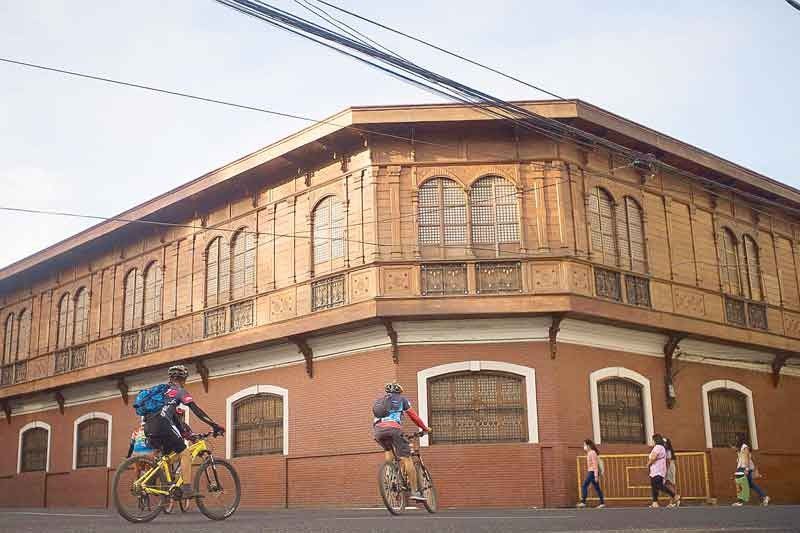Iloilo is in love with arts & culture


An imposing building on J. M. Basa corner Ortiz streets of Iloilo City tells of a century-old story. The patina of the wooden structure of the building’s second floor is heightened by time. Its Spanish colonial architecture tells of progress and growth, of days of plenty, of genteel charm. From a distance, its grandeur attracts one to eavesdrop on what could be happening in the dwelling.
Inside it, as one will discover, centuries-old accounts of trade and commerce that shaped the Philippines are displayed as the building is now turned into The Museum of Philippine Economic History.
The transformation of the Elizalde building, formerly known as the Commission on Audit (COA) building, into a museum is remarkable, striking even. Why not when the Filipino identity — its form, soul and tapestry — is defined in terms of economic history.
The new museum, a project of Senate Minority Leader Franklin Drilon and administered by the National Historical Commission of the Philippines (NHCP), is a significant addition to the slew of projects for the restoration of key heritage and culture sites in Iloilo. The restoration project started five years ago when Drilon, a true-blue Ilonggo and a staunch vanguard of Iloilo’s arts and culture, launched the Iloilo Heritage and Urban Renewal Project that aims to protect and preserve the province’s rich heritage and culture.

St. Anne Parish Church, also known as Molo Church.
“The Museum of Philippine Economic History is the first of its kind in the Philippines,” Drilon tells Allure at the recent opening of the museum.
“A hundred years ago, Iloilo was known as the ‘Queen’s City of the South.’ Iloilo was the center of commerce south of Manila at the turn of the 20th century,” he adds.
Drilon informs us that the Elizalde building is a hundred-year-old complex whose architecture depicts the age of progressive commerce and trade in Iloilo during the 18th to early 20th century. It was formerly owned by one of the country’s biggest trading firms during the 18th century, the Ynchausti y Compañia, of the Ynchausti family. The firm’s name was synonymous with its products like Yco Floor Wax, Yco Paints, Tanduay Rum and Rizal Cement.
By the late 1920s, Ynchausti y Compañia came under the management of the Elizalde family until the COA bought the building.

(Left) Looms from the oldest weavers of Miagao in Iloilo. (Right) A Machuca-tiled open space welcomes guests to the museum.
Now, the museum tells of a rich narrative of Philippine economic history. On the Machuca-tiled ground floor (about 760 square meters) can be found three galleries: History of the Ynchausti y Compañia Building, History of Iloilo as Regional Economic Center, and the Economic History of the Philippines. (An open space, resided only by two marble tables with wrought-iron chairs, welcomes one at the museum’s ground level, as if telling one to empty one’s mind because it will be filled later on with significant discovery at the museum.)
A grand staircase made of hardwood escorts one to the second level of the museum to discover the industries that shaped Philippine history. Every step forward at the grand staircase is a step back in time. A gallery each is devoted to abaca, pottery, rice, boat making, tobacco, body ornaments, coconut, blacksmithing, sugar and textile. Each gallery is ingeniously introduced by a wooden divider with carvings depicting what the gallery will showcase.

The grand staircase of the museum.
Lounge deeper into the museum and you will discover that Iloilo was once the rice granary of the archipelago as it supplied food to Spanish troops, even to Mindanao. In the industry of textile, Iloilo was to the Philippines what St. Gallen was to Switzerland. The textile became the chief export of Iloilo in the 19th century. However, when European and American clothes were introduced in the Philippines, the Iloilo textile industry suffered a decline. But the Ilonggos are resilient in times of a slump. They soon focused on sugar production. And the rest is history.
Now, the Museum of Philippine Economic History boasts hundred decades-old artifacts and items on display, including old San Miguel beer bottles from the Ynchausti clan; molino de sangre, which was a very important tool in the Western Visayas region’s sugar industry; decades-old gold, necklace and other accessories from Pampanga; looms from the oldest weavers of Miagao in Iloilo, then known as the textile capital of the Philippines; t’nalak from Mindanao; old photographs, maps, train wheels and plates.

Molino de sangre.
The Museum of Philippine Economic History is the third museum in Iloilo that has opened since 2018. The Megaworld Corp. opened the Iloilo Museum of Contemporary Arts and the National Museum opened its Western Visayas Regional Museum in the old Iloilo Provincial Jail.
The cultural discovery of Iloilo did not end at the visit at The Museum of Philippine Economic History. Upon the invitation of Drilon and his beautiful wife Mila and the NHCP, some 2,000 Ilonggos were treated to a concert of the Philippine Madrigal Singers at the Molo Church. If the jampacked church is any indication, the Ilonggos are a cultured lot. Mind you, the bellboy I met in a hotel where I stayed two years ago queued up to listen to The Madz.

The Philippine Madrigal Singers perform at the Molo Church.
And The Madz did not disappoint as they made their audience laugh and cry with their renditions of spiritual, classic and pop songs. Their rendition of Panalangin sa Pagiging Bukas Palad moved Mrs. Drilon to tears, perhaps because the song, sung inside the church, made her closer to God. (“I felt every word that they sang,” she said.) I, too, shed a tear because in The Madz I heard the voice of the divine. And singer Jose Mari Chan must have hurt his palms from clapping vigorously after every song. The award-winning singing group sang 18 songs, including Love of My Life, Man in the Mirror, Queen of the Night, Limang-dipang Tao, Pangarap Ko ang Ibigin Ka and Bituing Walang Ningning.
With the launch of The Museum of Philippine Economic History and the concert of the Philippine Madrigal Singers, Iloilo’s art and culture scenes are undeniably pulsating and alive.
(For your new beginnings, e-mail me at bumbaki@yahoo.com. I’m also on Twitter @bum_tenorio and Instagram @bumtenorio. Have a blessed Sunday! - Photos by Büm Tenorio Jr.















